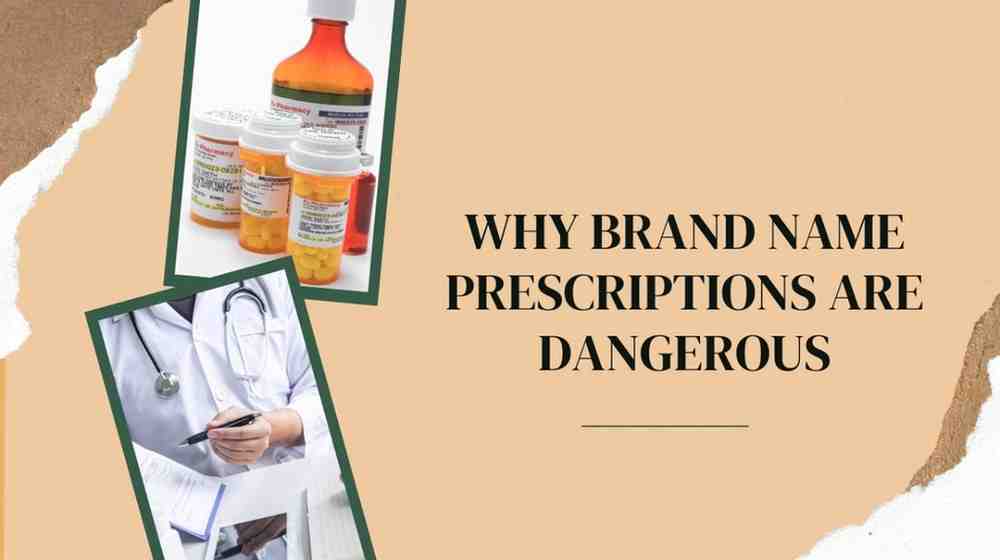Last updated on May 20th, 2025 at 12:48 pm

Prescription By Brand Name Is Dangerous: Prescribing medications by brand name rather than their generic counterparts introduces a host of dangers into the healthcare landscape. One significant concern is the potential economic burden on patients, as brand-name drugs tend to be more expensive, limiting accessibility and affordability. This practice also heightens the risk of medication errors and confusion, both for healthcare providers and patients, due to the similarities between generic and brand names.
Additionally, the lack of interchangeability between certain brand-name drugs and their generic equivalents can impede flexibility in treatment options. By focusing on brand names, healthcare professionals may inadvertently limit their ability to adapt to changes in drug availability, pricing, and regulatory developments, hindering patient care. Encouraging the use of generic names in prescriptions not only addresses these issues but also promotes patient empowerment and informed decision-making, fostering a more collaborative and effective healthcare environment.
Solution To: Dangerous Effects of Brand Name Prescriptions
Prescribing medications by brand name rather than generic names poses several risks to patient safety and healthcare efficiency. While brand-name drugs are designed to meet specific quality standards, relying solely on their prescription can lead to increased costs, confusion, and potential health hazards. It is essential to explore solutions that address these dangers and promote a safer and more cost-effective healthcare system.
Encourage Generic Prescribing
- Implement policies and educational programs to encourage healthcare professionals to prescribe generic drugs whenever possible.
- Highlight the FDA’s rigorous standards for generic drug approval, emphasizing their bioequivalence to brand-name counterparts.
- Develop incentives for healthcare providers to choose generic alternatives, such as cost savings for both patients and healthcare systems.
Enhance Health Literacy
- Educate patients about the differences between brand-name and generic medications, emphasizing that generic drugs are equivalent in terms of safety and efficacy.
- Encourage patients to ask their healthcare providers about generic alternatives, fostering a more informed decision-making process.
- Utilize accessible and clear communication tools, such as pamphlets, websites, and community outreach programs, to improve health literacy on this matter.
Implement Electronic Prescribing Systems
- Utilize electronic health records (EHRs) to streamline the prescription process and reduce the likelihood of errors related to brand-name confusion.
- Integrate drug databases into EHR systems, allowing healthcare professionals to access comprehensive information about both brand-name and generic medications.
- Provide training to healthcare providers on the effective use of electronic prescribing systems to enhance accuracy and efficiency.
Enforce Clear Prescription Standards
- Establish standardized prescription practices that emphasize the use of generic names, reducing the likelihood of confusion at pharmacies.
- Implement regulatory measures that discourage the use of brand names unless necessary, ensuring a more consistent and cost-effective approach to prescribing medications.
Collaborate with Pharmacists
- Foster collaboration between healthcare providers and pharmacists to ensure accurate dispensing of medications and to address any concerns related to brand-name prescriptions.
- Encourage pharmacists to proactively communicate with prescribers if there are potential issues or discrepancies in a prescription.
- Implement regular training sessions for pharmacists to stay updated on generic drug availability and bioequivalence.
Insurance and Payer Incentives
- Work with insurance providers and payers to develop incentive programs that promote the use of generic medications.
- Offer reduced copayments or coverage incentives for patients who choose generic alternatives, creating a financial motivation for both prescribers and patients.
Generic VS. Brand-name Medicines
Generic medications, equivalent in quality and effectiveness to their brand-name counterparts, offer a cost-effective alternative. While both versions contain the same active ingredients, generics typically come at a lower price due to reduced marketing and development expenses. The rigorous approval process by regulatory agencies ensures their safety and efficacy.
Patients and healthcare providers can confidently choose generic options, saving on healthcare costs without compromising on quality. This shift towards generic prescribing fosters accessibility, and affordability, and contributes to a more sustainable and equitable healthcare system.
Read: What are Generic Medicines?
Conclusion
While brand-name medications undoubtedly play a crucial role in healthcare, healthcare professionals need to approach prescription practices with a balanced perspective. Emphasizing generic prescribing can improve patient access, reduce the risk of medication errors, and empower patients to actively participate in their healthcare decisions. Ultimately, prioritizing generic names in prescriptions aligns with achieving optimal healthcare outcomes for all.
At MedKart, we recognize the importance of prioritizing patient well-being and cost-effective healthcare solutions. Our commitment to safety and accessibility is reflected in our unique approach – providing medicines based on the molecule. By focusing on the active ingredient rather than brand names, we empower both healthcare providers and patients to make informed decisions, ensuring that medications are selected based on their efficacy, safety, and affordability. This approach aligns with the broader goal of creating a healthcare landscape that prioritizes patient outcomes and fosters a culture of responsible and informed prescription practices.
> Consult a Doctor and Medkart will help you Order Medicines Online
FAQs On Why Prescription By Brand Name Is Dangerous?
Q1. Why Prescription By Brand Name Is Dangerous?
Prescribing by brand name can be dangerous due to potential confusion, increased costs, and risks of medication errors. It may compromise patient safety as generic equivalents are often available at lower prices, with the same efficacy. Standardizing prescriptions by generic names can mitigate these risks.
Q2. What Are The Disadvantages Of Brand Name Drugs?
Brand-name drugs often incur higher costs due to research, development, and marketing expenses. Additionally, patients may face limited insurance coverage and increased out-of-pocket expenses. The exclusive patent protection of brand-name drugs can hinder the availability of more affordable generic alternatives.
Q3. How does prescribing by brand name impact patient safety?
It poses a risk to patient safety by potentially causing confusion at pharmacies and increasing the likelihood of medication errors, as generic equivalents are often available at a lower cost without compromising safety or effectiveness.
Related Links: